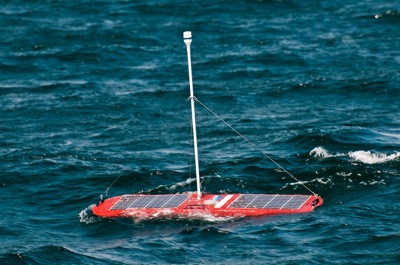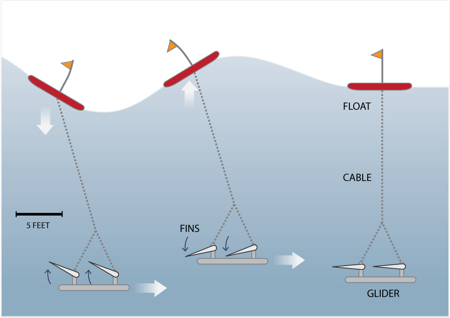Thayer Walker is a San Francisco-based freelance writer, who first reported on development of the Wave Glider for The New York Times. His radio segment for Climate Watch, was produced by Nathanael Johnson and is scheduled to air Monday, 8/31 on KQED’s The California Report.
Red Flash in the Sunset
By Thayer Walker
A Silicon Valley engineering firm called Liquid Robotics recently launched a new device called a Wave Glider off the California coast. It’s the latest and perhaps, the most ingenious design in the growing network of “autonomous ocean samplers,” which is to say sea-going science robots. The glider is a sensor-carrying platform powered entirely by wave energy and it has the potential to collect an enormous amount of data about the ocean, which in turn will give scientists a better understanding of climate change.

Jim Bellingham, Chief Technologist at the Monterey Bay Aquarium Research Institute, calls the device a “transformational development” in the field of ocean science and technology, but when the inventors came up with the idea they weren’t trying to revolutionize marine studies, they were trying to eavesdrop on humpback whales.
In 2005, Joe Rizzi, the chairman of Liquid Robotics, wanted to listen to the song of humpback whales off the coast of his home in Puako, Hawaii. He anchored a hydrophone near the shore, but instead of picking up whale song he heard the sound of frying bacon. Snapping shrimp, a small crustacean that uses its powerful claw to generate sound blasts that stuns its prey, had drowned out the call of the whales.
When Rizzi moved the hydrophones into deeper water he captured clear whale sounds, but kept losing the moored devices to rough seas. “The difficulty,” says Rizzi “was holding a hydrophone anchored in 600 feet of water during winter storms.” Rizzi realized that to keep a hydrophone stationary, he would need a powered device. “You’re not going to do that with a battery and a motor and a solar panel,” he explains. “The amount of power to hold station in a 60 mile per hour wind and 10 foot waves is thousands of watts. We recognized that it’s an energy problem.”
Rizzi presented the problem to Liquid Robotics CEO Roger Hine, who quickly came up with a design, and the Wave Glider was born. “We weren’t sitting around thinking this thing would have a lot of scientific uses,” says Rizzi, “but as it turns out, there are a lot more uses for this device than just listening to whales.”

